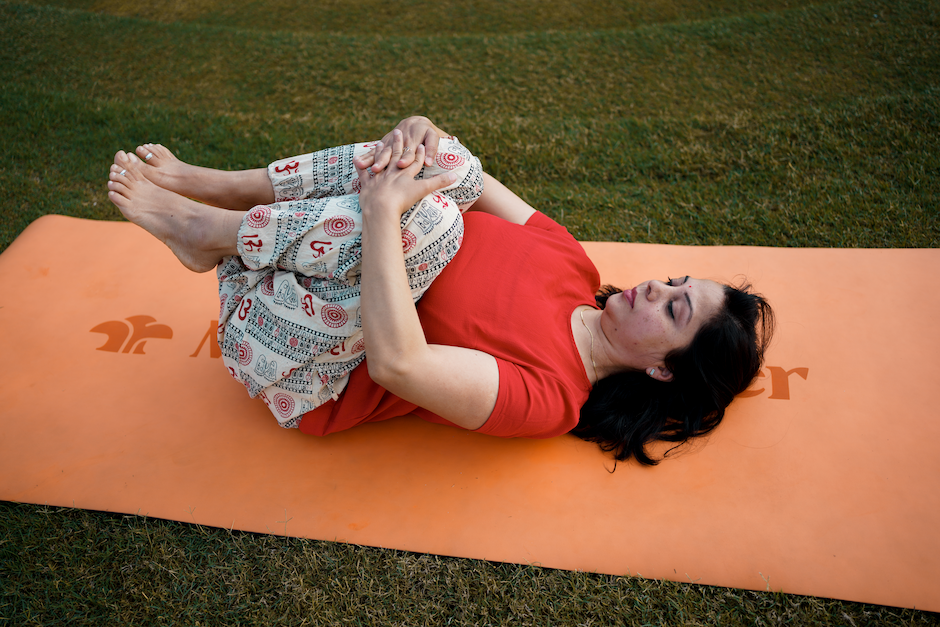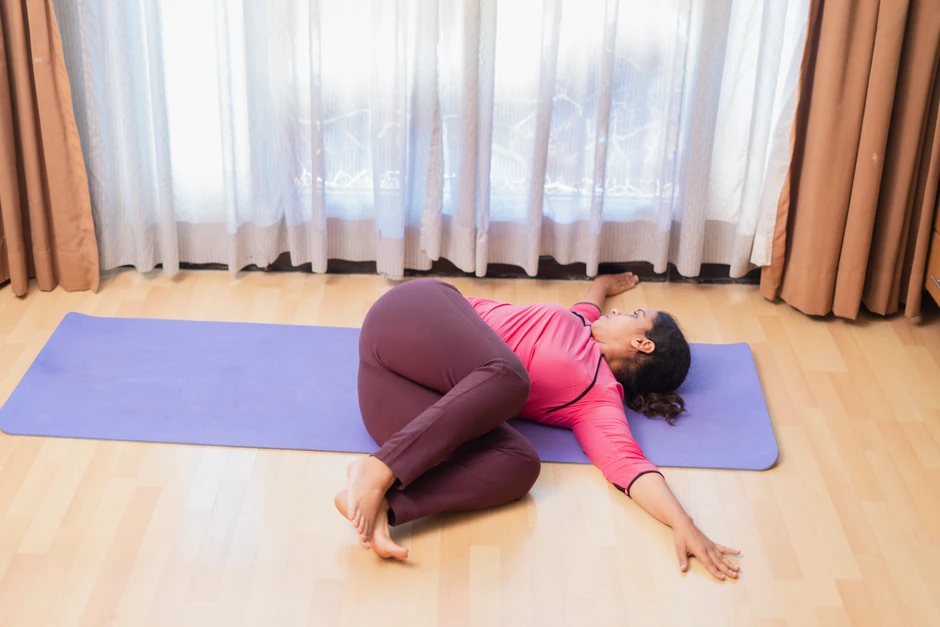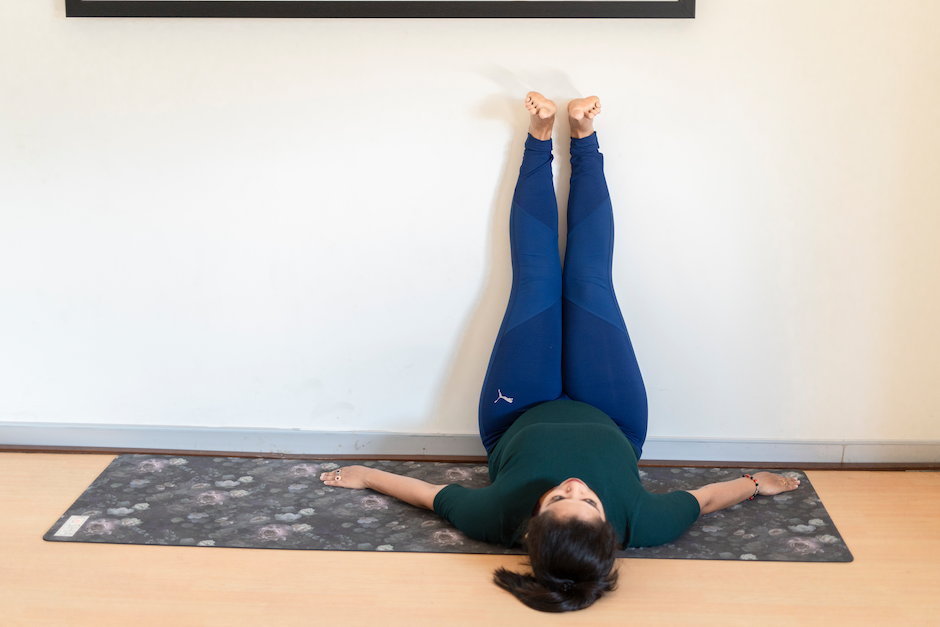
%20(7).jpg)
Yoga can significantly improve gut health by activating the parasympathetic nervous system, reducing inflammation, and strengthening the gut-brain connection through vagus nerve stimulation.
Research shows that regular yoga practice helps balance the gut microbiome, reduce symptoms of conditions like IBS and IBD, and support overall digestive function — all while lowering stress, a key trigger for gut disorders.
Through gentle movement, calming breathwork, and mindful relaxation, yoga activates the body’s natural “rest and digest” mode. This supports nervous system regulation and physically stimulates digestive organs, helping to relieve common symptoms like bloating, constipation, and sluggish digestion.
Continue reading to discover how yoga supports gut health, explore 8 science-backed poses and breathing techniques, and follow simple daily routines to improve your digestion.
Yes! Yoga is increasingly recognized as a powerful support tool for gut health. Regular yoga practice can help relieve digestive symptoms, improve gut motility, and reduce inflammation by calming the nervous system and strengthening the gut-brain connection.
Let’s break this down:
[inline-CTA-1]
These yoga poses are specially chosen to support digestion, reduce bloating, and stimulate your gut through gentle compression, twisting, and calming the nervous system.

Gentle compression boosts blood flow to your abdominal organs and stimulates peristalsis (intestinal movement). It also activates your parasympathetic nervous system, which is essential for digestion.
Twisting massages the digestive organs and promotes elimination, especially helpful for constipation and sluggish digestion.

This pose offers a gentle massage to your digestive tract and is extremely calming for the gut-brain axis.

The compression of the abdomen helps move gas and waste through your intestines.

The spinal movement activates abdominal muscles and massages the gut, aiding mobility and circulation.

Reclined twists are gentle but effective at stimulating the digestive organs, especially after a meal (with sufficient rest).

This inversion reduces pressure on the gut, encourages lymphatic flow, and activates the "rest and digest" mode.

Complete relaxation is when your body focuses on repair, including digestion. This pose is essential for nervous system regulation.
Breath is one of the most powerful — and often overlooked — tools for gut healing. Specific breathing techniques help regulate your nervous system, reduce stress hormones, and gently massage your digestive organs from the inside out.
Here are three science-supported breathwork practices that support gut health:

This technique is deeply calming and balances both hemispheres of the brain — ideal for easing gut-brain axis tension.

Ujjayi breath gently tones your vagus nerve — boosting gut-brain communication and digestion.
Dirgha breathing helps expand abdominal muscles and improve circulation to the digestive tract — ideal before Savasana or meditation.
[inline-CTA-2]
Yoga can be a powerful tool for managing and improving a wide range of gut-related conditions — especially those linked to stress, inflammation, and irregular digestion.
Let’s break it down into two main categories:
These conditions often involve chronic inflammation and immune dysfunction. Yoga can help by reducing stress (a known trigger), calming the nervous system, and gently supporting digestion during flare-free periods.
For conditions like IBD, always consult a doctor. Avoid intense poses during flares, and focus on restorative practices.
These are common, non-inflammatory issues that many people face daily. Yoga is particularly effective here, as it addresses both physical and nervous system components.
Gentle movements, breathwork, and stress relief can dramatically improve how your gut feels and functions day to day.
You don’t need an hour-long class to support your gut. Just 10–15 minutes a day of intentional movement and breath can make a noticeable difference. The key is consistency and listening to your body.
Here’s how to structure your routine:

The choices you make off the mat are just as important for maintaining balance and supporting your digestive system long term.
Here are some simple, science-backed lifestyle habits to complement your yoga practice:
Struggling with gut issues? Let expert Indian yoga teachers guide you with gentle, personalized sessions designed to heal your digestion.
Start your free trial today and feel the difference.
Most people notice reduced stress and better sleep within 1–2 weeks of regular practice. More noticeable digestive improvements — like less bloating or more regular bowel movements — typically show up after 4–6 weeks of consistent practice (3–5 sessions per week).
Yoga isn’t a cure, but it can significantly improve quality of life, symptom management, and stress resilience when combined with medical care.
In IBS, studies show reduced pain, bloating, and anxiety. For IBD, yoga may support flare-free periods and emotional well-being.
Yoga is ideal for anyone dealing with digestive issues like bloating, gas, constipation, IBS, or IBD. It’s especially helpful if your symptoms are linked to stress or a nervous system imbalance.
People recovering from antibiotics or looking to support their gut microbiome can also benefit. Just start gently, and consult your doctor if you have severe inflammation, recent surgery, or hernias.
Yes. These poses to avoid include:
No! Yoga is complementary, not a replacement.
It works best alongside your medical treatment to help reduce symptoms, manage stress, and improve long-term outcomes. Always consult your healthcare provider before changing your treatment plan.

Receive personalized guidance tailored to your unique fitness goals, live with a dedicated coach—no credit card required.